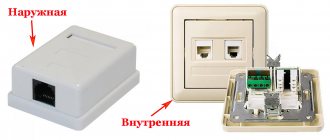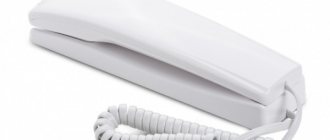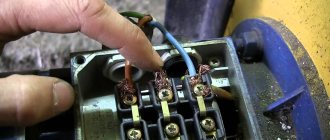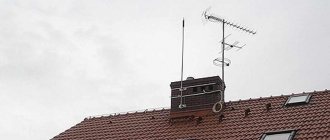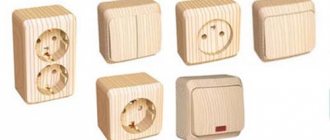When purchasing a built-in oven, sellers recommend entrusting the connection of the equipment to professionals. But this service, even with normal wiring, costs about 1,500 rubles (about $25), which is already a lot. And if you have to pull the line from the shield, the cost increases even more, and significantly. But an ordinary person who knows how to hold a screwdriver in his hands can connect the oven with his own hands. Laying a separate power supply line is more difficult, but it can also be done. The only disadvantage of such actions is that you will not have the corresponding column filled in in your passport. Based on this, you may be denied warranty repairs if a warranty case suddenly arises. So the choice is yours.
An independent oven can be installed in a pencil case
Electric ovens come in two types - dependent and independent. Dependents come with the hob and are connected with it to the same power source. They should be located nearby, usually the hob above the oven. They are connected to each other by cables, since the position of the oven controls affects the operation of the hob. All requirements are detailed in the instructions and must be followed exactly.
Independent ovens are completely autonomous devices that connect independently. The choice of their installation location is also arbitrary. That’s probably why such models are more popular.
Types of ovens
Before connecting the oven, you need to find out its power.
Correct connection of an electric oven is possible if the user has figured out the type of model purchased in advance. It is often sold complete with the hob, and sometimes separately. Based on this criterion, products are divided into dependent and independent samples. According to the instructions, the first of them must be connected to a power source along with the panel, which significantly complicates the upcoming work. As a rule, these two products are located next to each other and have a common control panel.
The devices are connected to each other by a separate cable, ensuring their joint switching during operation.
Independent ovens are completely autonomous devices, the connection of which to a source of electricity is not conditioned by anything. In this regard, the area of their installation within the kitchen can be chosen at your discretion, which should be attributed to the advantages of models without a stove.
Installing a hob: sequence and rules
Installation of standard hobs must be carried out in accordance with the following rules and recommendations:
- The hob must be mounted on a horizontal, flat surface; ignoring this requirement may lead to deformation of the metal parts of the device and disruption of the functioning of the ceramic surface.
- Screw short screws to the standard holes, which are located on the sides;
- To install the panel in the kitchen set as smoothly as possible, you need to lightly press the center of the device to level the horizontal surface with a laser level;
- After complete installation, secure with fasteners. The centering plate bolts must remain accessible;
- If the hob is installed without following the instructions in the operating instructions, this may affect the performance of this appliance.
Connection options for one of the models
Selecting a location
Before installing the electric oven, you will need to carry out a number of preparatory operations.
- First of all, you should decide on the place where you intend to install the product. Its choice depends on the requirements of building codes, as well as on the type of oven purchased (open or built-in model).
- It is necessary to select the area for placing the connecting block or socket (if included in the kit).
- You should also evaluate the possibility of installing the hood in the location chosen for the cabinet.
These factors are important because they indirectly affect how you connect to the electrical network.
Depending on the location, the length of the power cable laid to it and the installation area of the socket with a grounding contact will be selected.
How to change a plug on a wire
Repairing a power plug is not difficult, but it is very important to follow personal safety precautions while performing work.
How to disassemble an electrical plug type C1-B
It is necessary to prepare the ends of the wires for connection. To do this, the cord is cut at intervals of no more than 5 cm from the plug. If the plug overheats due to an unreliable connection, as a rule, the insulation in these places becomes hard and must be replaced. Rings are formed at the ends of the wire. After this, spring groovers and flat washers are installed on the screws. Now this design can be inserted into the screws.
The screw must be screwed into the pin until it stops. The wire is connected to the second pin in a similar way. They are mounted with protrusions in the housing in special recesses. A strip is placed on the wire and pressed to the body using two screws. If the insulation is thin, in order to prevent it from rubbing where it exits the structure, it is recommended to put a polyvinyl chloride or rubber tube over the insulating layer.
Replacing electrical plug type C1-B
Finally, connect the halves of the housing and tighten them with a nut and screw. If the two halves of the wire are prevented from touching tightly, they need to be moved away.
How to connect a three-pole C6 plug to a wire
Preparing the wire for connection is carried out in the same way as in the previous section. The assembly technology is the same.
If the kit does not include grower plugs, they must be installed. The yellow-green wire can only be connected to the ground contact. As a rule, it is located in the middle between the contact pads of the pins.
The two-pole cord does not have a grounding contact, therefore, this place will remain free in the plug.
Oven power
Energy consumption classes of ovens
Before connecting an electric oven with your own hands, you should know that according to the level of energy consumption, these products are divided into several classes, designated by the letters A, B and C. In accordance with this classification principle, all models belong to different groups according to efficiency. This breakdown is directly related to the power rating of the oven, regardless of its size and design (whether it is a built-in model or not).
Economical products belonging to classes “A+” and “A++” (corresponding to electrical power up to 0.6 kW) are characterized by minimum consumption. The typical value for most models ranges from 1 to 4 kW. Based on these indicators, it is possible to calculate the electrical parameters of the supply line supplied to them, including the cross-section of the working cable cores and the setting of the circuit breaker.
For the average consumer, this classification is interesting from the point of view of the speed of cooking in the oven. There is a direct connection between the power of the unit and the cooking speed. For optimal heating, experts advise choosing models with a power of no more than 2.5-3 kW. This guarantees fast cooking at operating temperatures of about 220 degrees, sufficient for high-quality heat treatment.
Features of connecting the built-in oven to the mains
Before connecting the oven to electricity, it is important to know that you can connect it to the household electrical network directly (through a special socket). If the kit includes a special socket with grounding, you can connect to the line using it.
For installation, you will need the diagram provided in the instructions supplied with the product. In it, all contacts are color-coded, according to which it becomes clear where the phase wire should be connected and where the neutral wire should be connected. There are also jumpers indicated that allow you to form the necessary power supply circuits of 220 or 380 Volts.
Selecting a power cable and circuit breaker
To understand how ovens are connected to a 220V outlet, you first need to understand the issue of connecting the power supply to it. When studying its scheme, it is important to consider the following points:
- To supply power to the oven, you will need a separate line with a machine with a rated operating current of at least 32 Amps.
- The cross-section of the wires being laid is selected so that it does not overheat at maximum load (at least 4 square millimeters).
- To power the oven you will need a three-wire cable with a grounding bus.
- When laying it, the requirements of the PUE are taken into account, which indicate the permissible distances from building elements and other communications.
The requirements of the PUE must be followed, even if the apartment has two-wire wiring. This will allow you not to have to update the oven power line in the future (when installing a new electrical network).
After solving the issues with the wiring, it is important to figure out how best to connect the oven - using a socket or using a block. The choice of inclusion option depends on many factors, as well as the preferences of the owner. On the one hand, a block mounted on the wall and covered with a lid provides more reliable contact than the most powerful socket. However, in terms of ease of connecting the wiring and disconnecting it from the network, it is clearly inferior to a socket connection, in which you just need to remove the plug.
The use of the block is justified if there is a separate automatic device that turns the oven off manually.
Another case when you can’t do without a block is if the purchased oven model is designed for three-phase power. This option is more suitable for owners of private houses, in which it is possible to connect a three-phase power cable only through terminal contacts.
Testing
Before finally installing the oven on the workplace, it is recommended to test it for functionality. To do this, turn on the machine that supplies power to it and use a tester to check the voltage at the block or terminals of the socket. The device should show a value of 220 Volts or a little more, which immediately disappears after turning off the machine. After testing is completed, you can safely turn on the oven and then try to cook something in it.
Turning on the induction cooker after installation
Turning on the induction cooker after installation is carried out according to important rules:
- Before putting into operation, the product must be cleaned of dirt, glue residues and preservative lubricants using special detergents that do not contain abrasives;
- The stove is turned on by pressing the “Network” button;
- If the panel connection is carried out correctly, then after voltage is applied, a sound signal is triggered;
- after a few hours of operation of the device, an unpleasant smell of burnt rubber or plastic may appear, which soon burns and disappears;
- turning on one of the cooking zones occurs using a button and a power regulator with graduation from 0 to 9;
- when several cooking zones are operating simultaneously, the display shows the time countdown on the zone that is closer to the end of the process. The display of adjacent cooking zones flashes.
Hob installation should be left to a professional.
Operational safety
Connecting an RCD for an oven
For safe operation of an oven that has been built into kitchen furniture or placed separately, it will be necessary to protect the user from accidental contact with dangerous potential on its body. For this purpose, switching products are equipped with a special terminal that has an electrical connection to the protective grounding system.
Some experts recommend including a residual current device in the power circuit that is triggered by the slightest leakage current. The protection option with an RCD makes sense in cases where a two-wire power cable is installed in the apartment, that is, there is no reliable and complete grounding in it.
How to replace a broken Euro plug
Before starting installation work, you need to make sure that the cable and plug are not connected to a 220 Volt network! This is to avoid electric shock!
Now you need to figure out what type of fork, since this is the factor that affects the assembly algorithm. As a rule, in most cases, a non-separable three-wire plug is used for household appliances. We owe this design feature to engineers who have significantly speeded up and reduced the cost of production of cast forks. And of course, this design did not go unnoticed by marketers; the plug broke, buy a new household appliance. Such principles have long been in effect in Japan and Europe. Well, since we are Russians, and we won’t be scared by replacing non-separable forks, then let’s get started!


